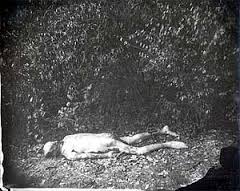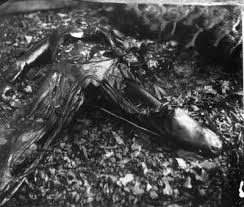The third stage of decomposition known as “Rigor Mortis” translates to “stiffness” [rigor] “of death” [mortis]. The stiffness in a body during the phase of Rigor Mortis is caused by a build up of lactic acid which causes chemical changes within muscles. In life, lactic acid, also known as “milk acid” plays various roles in a body’s biochemical process. The myosin and actin (proteins involved in muscle movement) in the body then begin to harden, causing all muscles in the body to harden for a period of time, as well. At the time of death, “primary flaccidity” occurs and Rigor Mortis begins within 2-6 hours of death, starting with the eyelids, neck and jaw before spreading throughout the rest of the body over the following 4-6 hours. Sometimes all the hardening and contracting of muscles can cause an involuntary postmortem ejaculation in a male corpse. The exact onset and rate of completion of this stage is determined by many factors including age, gender, body type and muscle build; For instance, Rigor Mortis may not be perceivable in infants and children who lack muscle mass. Rigor Mortis may develop more quickly if cause of death is an infection, terminal seizure, electrocution or if the deceased has recently engaged in strenuous exercise or had a higher than average body temperature caused by fever, drugs or intoxication. Generally, 36-48 hours after death “secondary flaccidity” occurs when bacteria in the body begins eating away at the deceased from the inside out, causing the body to end Rigor Mortis and loosen again as muscle tissue begins to deteriorate. Sometimes, it can take 72 hours for the body to reach secondary flaccidity. In a warm environment, Rigor Mortis tends to dissipate sooner than average, whereas in a cold climate, the effects may persist longer.
Check out the NEW BOOK by The Post-Mortem Post’s Head Writer ‘Horrible History: Mass Suicides’ AVAILABLE NOW on Amazon Kindle!
Find out what happens prior to Rigor Mortis, Stage 1: Pallor Mortis and Stage 2: Algor Mortis and after Stage 4: Livor Mortis
Follow us on Twitter @PostMortem_post
If you enjoyed this article, you may also like Everybody Poops: The Post-Mortem Edition and Demystifying the Process of Dying







 This caused quite a bit of uproar from residents of Chihuahua who weren’t too thrilled knowing they would be walking past the corpse of a young woman on a regular basis. Eventually, most citizens became used to Pascualita staring at them through the window as they strolled around downtown. Som revel in the presence of this local oddity and view her as a sort of landmark which brings in a flock of tourists from Europe, South America and the United States each year. This story however, may be entirely, or at least partially legend. Many older residents of the area swear the body is truly that of the deceased Pascualita Esparza but just as many claim that shortly after the town went into an uproar over her display in the window, Pascuala made a statement that the body was not her deceased daughter. Obviously, the most logical theory is that Pascualita is a very life-like mannequin that was incredibly impressive for the time period; Perhaps Pascuala started an itty bitty rumor in an attempt to draw in customers to the store. One thing which keeps people questioning the authenticity of Pascualita is the small, lifelike and possibly decomposition related-imperfections such as the deep folds of her palm.
This caused quite a bit of uproar from residents of Chihuahua who weren’t too thrilled knowing they would be walking past the corpse of a young woman on a regular basis. Eventually, most citizens became used to Pascualita staring at them through the window as they strolled around downtown. Som revel in the presence of this local oddity and view her as a sort of landmark which brings in a flock of tourists from Europe, South America and the United States each year. This story however, may be entirely, or at least partially legend. Many older residents of the area swear the body is truly that of the deceased Pascualita Esparza but just as many claim that shortly after the town went into an uproar over her display in the window, Pascuala made a statement that the body was not her deceased daughter. Obviously, the most logical theory is that Pascualita is a very life-like mannequin that was incredibly impressive for the time period; Perhaps Pascuala started an itty bitty rumor in an attempt to draw in customers to the store. One thing which keeps people questioning the authenticity of Pascualita is the small, lifelike and possibly decomposition related-imperfections such as the deep folds of her palm.


